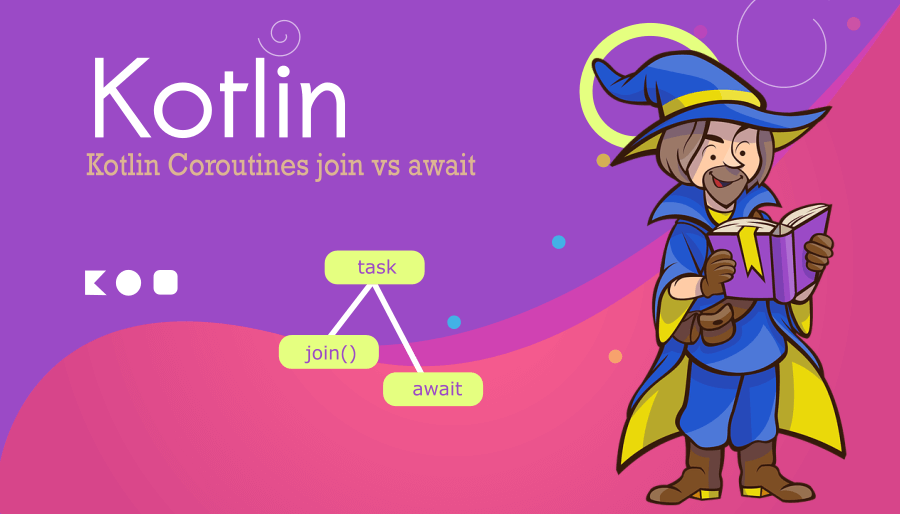Kotlin Coroutines join vs await: Handling Explicit Jobs [Examples]
In this tutorial, we’ll look into Kotlin Coroutines join() function and its usage and example. We’ll also discuss the pros and cons of join() and explore best practices for using it.
What are Kotlin Coroutines? [simple explanation]
Kotlin coroutines are a useful tool for writing code that can do many things at once without slowing down the main part of the program. This makes them great for creating applications that respond quickly and work efficiently.

Handling An Explicit Job using Kotlin Coroutine join()
The launch coroutine builder returns a Job object, which serves as a handle to the launched coroutine and allows explicit waiting for its completion. This can be useful for ensuring that all of the tasks in a workflow are complete before moving on to the next step.
How to use join()
To use join(), you first need to get a reference to the Job object of the coroutine that you want to wait for. You can do this by using the launch() or async() function to start the coroutine.
Once you have a reference to the Job object, you can call the join() function. This will suspend the current coroutine until the coroutine associated with the Job object completes.
Kotlin Coroutines join example (1)
import kotlinx.coroutines.delay
import kotlinx.coroutines.launch
import kotlinx.coroutines.runBlocking
fun main() = runBlocking {
val myJob = launch { // launch a new coroutine and keep a ref
delay(2000L)
for (i in 0..<5 step 1) println("*")
println("Hello Stars")
}
println("Star night!!")
myJob.join() // wait until child coroutine completes.
println("All Stars are rendered!")
}
Output
Star night!!
*
*
*
*
*
Hello Stars
All Stars are rendered!Kotlin Coroutines join example (2)
import kotlinx.coroutines.*
fun main() = runBlocking {
val job = launch {
delay(1000L)
println("Hello, Jack!")
}
// Wait for the job to complete
job.join()
println("Job completed. I'm done")
}
Hello, Jack!
Job completed. I'm doneWhen to use Kotlin’s join()
There are a few different situations where you might want to use join():
To ensure all tasks in a workflow finish before proceeding to the next step
As an example, when building a web application, you may find it beneficial to utilize join() to ensure that all database queries finish before sending a response to the client
The completion of multiple coroutines
For instance, if you’re creating a game, you could use join() to pause and wait until all players have finished their turns before moving on to the next round.
Benefits of using join()
- It allows you to wait for the completion of a coroutine without blocking the main thread. This is important for writing responsive and efficient applications.
- It makes your code more readable and maintainable. By using join(), you can explicitly specify when you want to wait for the completion of a coroutine. This makes it easier to understand and debug your code.
Drawbacks of using join()
It can lead to deadlocks. If two coroutines are waiting for each other to complete, this can create a deadlock. To avoid deadlocks, you should use join() carefully and avoid creating circular dependencies between coroutines.
It can reduce the performance of your application. If you are waiting for a long-running coroutine to complete, this can block the current coroutine and prevent it from doing other work. To improve the performance of your application, you should avoid waiting for long-running coroutines to complete.
Best practices for using join()
Here are a few best practices for using join():
Use join() sparingly. Only use join() when you need to wait for the completion of a coroutine. If you don’t need to wait for the completion of a coroutine, you should avoid using join().
Avoid creating circular dependencies between coroutines. If two coroutines are waiting for each other to complete, this can create a deadlock. To avoid deadlocks, you should use join() carefully and avoid creating circular dependencies between coroutines.
Kotlin coroutine join() vs await
The join() and await() functions are both suspending functions that allow you to wait for the completion of a coroutine before continuing. However, there are some key differences between the two functions.
join()
The join() function suspends the current coroutine until the coroutine associated with the Job object completes. The Job object is returned by the launch() and async() functions when you start a coroutine.
await()
The await() function suspends the current coroutine until the coroutine associated with the Deferred object completes. The Deferred object is returned by the async() function when you start a coroutine that returns a value.
Differences between join() and await()
The main difference between join() and await() is that await() can only be used with coroutines that return a value. The join() function can be used with all types of coroutines, regardless of whether they return a value or not.
Here is an example of how to use await()
import kotlinx.coroutines.*
fun main() = runBlocking {
val result = async {
delay(1000L)
return@async "Hello, Jack!"
}
// Wait for the result to be available
val message = result.await()
println(message)
println("Ok")
}
Output
Hello, Jack!
OkThe join() function is a powerful tool for controlling the execution of coroutines. By using join(), you can ensure that all of the tasks in a workflow are complete before moving on to the next step, synchronize the completion of multiple coroutines, and wait for a coroutine to complete before canceling it.



